Abstract
It seems certain that blended learning will be on the rise in higher education, with in-person meetings increasingly precious time, and online synchronous and asynchronous sessions used to complement them. This paper examines Knowledge Building in two graduate courses conducted during the COVID-19 pandemic. There were no in-person sessions; rather, synchronous Zoom sessions were combined with asynchronous work in a knowledge building environment–Knowledge Forum. Knowledge Forum is designed to make transparent and accessible means by which deep understanding and sustained creative work proceed. Accordingly, for example, rise-above notes and view rearrangement support synthesis and explanatory coherence, epistemic markers support knowledge-advancing discourse, and analytics support self-and group-monitoring of progress as work proceeds. In this report, we focus on these aspects of Knowledge Building, using a subset of analytics to enhance understanding of key concepts and design of principles-based practices to advance education for knowledge creation. Overall, we aimed to have students take collective responsibility for advancing community knowledge, rather than focus exclusively on individual achievement. As we reflect on our experiences and challenges, we attempt to answer the following questions: Do courses that introduce Knowledge Building in higher education need an in-person or synchronous component? In what ways can we leverage in-class time and Knowledge Forum work to engage students in more advanced knowledge creation? We conclude that synchronous and asynchronous Knowledge Building can be combined in powerful new ways to provide students with more design time and deeper engagement with content and peers.
1. Introduction
Due to the COVID-19 pandemic, in March 2020 higher education institutions in Canada swiftly shifted to emergency remote learning. Typically, online video conferencing replaced face-to-face interactions, with classes meeting at the same time as scheduled originally. As it became known that all courses were to be delivered online in the following Fall and Spring terms, instructors and course designers invested more time analyzing course content, goals, and structure in light of online requirements [1] and the need to engage students without face-to-face interaction.
In this paper, we reflect on our experience designing and delivering two courses to introduce students to Knowledge Building theory, pedagogy, and technology at a large post-secondary institution in Canada. Knowledge Building is an extensively researched innovative pedagogical approach that addresses the need for schools to be restructured as knowledge-creating organizations [2,3]. Two courses are offered to students enrolled in masters and PhD programs to introduce the key principles and concepts of Knowledge Building. Both courses involve students working as a community in design mode [4] to build on each other’s design work and advance community knowledge.
In both courses, individuals come together to tackle problems of understanding related to education for knowledge creation and to consider implications for their areas of expertise. We examine how ideas transform and become integrated across different community views created by students. There was not one stream of information, but different advances based on diverse student interests, complemented by efforts on the part of instructors and students to establish increasingly coherent community knowledge. In this paper, we discuss how ideas are articulated and progressively refined through multiple course components.
Changing course arrangements at a time when many students are experiencing social and emotional stress and turbulence is challenging. Bringing students together as a community to engage in collaborative and progressive design work, with students taking collective responsibility for community knowledge, represents yet another level of difficulty. Not only must knowledge building principles and concepts be integrated into students’ professional and personal learning trajectories, but the community must come together to envision education restructured as a knowledge-creating enterprise.
The goal of this paper is to highlight ideas implemented to engage students in principles-based, idea-centred design to advance a common objective and enable students to take greater responsibility for collective achievements. We reflect on our experience as course designers within the broader context of a Knowledge Building Research International team that looks to improve Knowledge Building courses: Do courses that introduce Knowledge Building require an in-person or synchronous component? In what ways can we leverage synchronous class time and asynchronous Knowledge Forum work to engage students in more advanced knowledge creation? Our collective goal is to establish a global network of research-based courses to advance education for knowledge creation.
2. Knowledge Building
Knowledge Building aims to engage students directly in the means by which knowledge in the world is advanced. It is akin to knowledge creation as practiced in research laboratories and other frontier-advancing organizations, amplified by a concern for educational benefit to the participants and to society. It focuses on the growing need for students to work creatively with ideas and to see themselves as active contributors in advancing community knowledge [5]. The essence of Knowledge Building is the production and continuous improvement of ideas to advance community knowledge [6]. Knowledge building discourse happens in “design-mode” [7,8], where the main concern is with the “usefulness, adequacy, improvability, and developmental potential of ideas” [7] (p. 57). It is facilitated by Knowledge Forum (KF), the technology designed to promote advanced knowledge work. Twelve principles convey the theoretical framework and workings of knowledge-creating communities [9,10]; the principles (indicated in italics throughout the text) are described below.
Knowledge Building is premised on the idea that each student is a legitimate contributor in the creation of authentic, creative knowledge work, and that “the state of knowledge in the classroom is an emergent distributed phenomenon that cannot be found in any one student’s mind” [11] (p. 399). In keeping with Vygotsky’s (1978) [12] theories of social constructivism and sociocultural learning, Knowledge Building accentuates the role of social interaction and collective responsibility. Additionally, it represents a complex systems account of new knowledge [13,14] and knowledge creation as an observable form of cultural practice and progressive enterprise [15]. It is distinguished by its emphasis on “deep constructivism”—on engaging students intentionally in taking collective responsibility for advancing community knowledge and exercising epistemic agency as they take charge of goals, designs, and progress evaluations normally handled exclusively by the teacher [6]. Design and innovation are central to Knowledge Building. As elaborated in knowledge building principles below, collaborative creation and advancement of public community knowledge requires idea improvement, Knowledge Building discourse as collaborative problem solving, and constructive use of authoritative resources to support ever-deepening understanding and emergence of new ideas and artifacts [5]. At the very heart of Knowledge Building is sustained creative work requiring interdisciplinary understanding that goes deep into complex, real-world problems and creates coherence and solutions, as in knowledge-creating organizations. In education contexts there is added emphasis on the well-being of contributors and innovation for public good.
Scardamalia [9,10] articulates 12 knowledge building principles to incorporate in practice:
Real Ideas, Authentic Problems. Authentic knowledge problems arise from efforts to understand the world; students address problems that matter to them, with their ideas real building blocks in knowledge creation.
Improvable Ideas. Ideas are treated as improvable. Community members work continuously to improve the quality, coherence, and utility of ideas.
Idea Diversity. Idea diversity is essential to the development of knowledge advancement. To understand an idea is to understand the ideas that surround it, including those that stand in contrast to it. Idea diversity creates a rich environment for ideas to evolve.
Epistemic Agency. Community members set forth their ideas and negotiate a fit between personal ideas and the ideas of others, using contrasts to spark and sustain knowledge advancement rather than depending on others to chart the course. They set goals and plans, and deal with problems that are normally left to teachers, managers, or other educational designers.
Community Knowledge, Collective Responsibility. Community members share the responsibility for advancing community knowledge. Contributions to shared, top-level goals of the organization are prized and rewarded as much as individual achievements.
Democratizing Knowledge. All members are legitimate contributors to the shared goals of the community. All are empowered to engage in knowledge innovation, and all take pride in knowledge advances achieved by the group.
Symmetric Knowledge Advancement. Knowledge is advanced through cross-team interactions as different community members and communities with different expertise contribute to what is known and to available resources.
Pervasive Knowledge Building. Knowledge Building is not confined to particular occasions or subjects but pervades mental life—in and out of school.
Constructive Uses of Authoritative Sources. To know a discipline is to be in touch with the present state and growing edge of knowledge in the field. This requires respect for and critical analysis of what is known, going beyond given source material to extend understanding through authoritative and other data sources.
Knowledge Building Discourse. Knowledge is advanced through discourse aimed at idea improvement. Discourse results in more than the sharing of knowledge; the knowledge itself is refined and transformed through the discursive practices of the community—practices that have the advancement of knowledge as their explicit goal.
Embedded, Concurrent, and Transformative Assessment. Assessment is embedded in the day-to-day workings of the organization, with the community assessing progress and identifying problems as work proceeds; it is integral to the effort to advance knowledge.
Rise Above. Creative Knowledge Building entails working toward higher-level formulations of problems and solutions. It means working with diversity, complexity, and messiness, to move beyond current best practices to achieve new syntheses and improved outcomes.
3. Literature Review: Knowledge Building in Higher Education
Knowledge Building requires work in design mode, with innovation as a goal and self-organization and emergence as key characteristics [16]. To achieve this transformation, teachers who adopt Knowledge Building engage in design and exploration of new practices, assessing those practices in light of student benefits [17,18,19] They share stories of their own experiences and perspectives, bringing principles-based knowledge building into their practices and engaging in co-design with other professionals so that the “knowledge that is co-created is greater than the sum of each individual member’s knowledge” [20] (p. 85). Assessment is part of the effort to advance knowledge; a knowledge building community needs to engage in its own internal assessment to identify problems as the work proceeds [21]. Previous studies examined implementation of Knowledge Building in graduate courses with prospective teachers and in other higher education contexts with students collectively advancing knowledge as they tackle educational problems, share perspectives, and generate new possibilities. To contextualize our research, we highlight previous studies with the stated goal of engaging graduate students as a knowledge building community.
Prior research has explored technology use, attitudes and perspectives, and pedagogical implementations of Knowledge Building—with results demonstrating its effectiveness as an innovative instructional approach [22]. For example, Gilbert and Driscoll [23] employed a case study methodology to explore how different instructional conditions promote a knowledge building community among 20 graduate students enrolled in one semester-long course at Florida State University. The conditions included (1) a collective and authentic goal (the design of a charter school), (2) students working in cooperative groups to achieve the goal, (3) self-selected readings to promote ownership, and (4) use of Construe, a technology to store and facilitate communication. The results showed that a task presented to students as authentic was not viewed by the students as authentic enough to foster collaborative work; the researchers suggested a shared vision might result in more collaboration. The researchers also determined that it is important to continuously track knowledge building to provide means of more support and feedback. As described in the sections below, in both of our courses we emphasized a shared vision to be refined or revised by students, in keeping with the Real Ideas, Authentic Problems principle, rather than a predetermined problem to be tackled. In addition, Knowledge Forum analytics are designed to enable continuous assessment of individual and community progress, in line with the Embedded, Concurrent, and Transformative Assessment principle. Another pedagogical implementation examined by Cesareni et al. [24] involved university students taking on scripted roles to foster discussions. The study was conducted over 15 weeks in a blended course with 143 students. The authors claimed that scripted roles can foster shared responsibility to advance the collective knowledge of the community. However, Bereiter and Scardamalia [25] raise concerns regarding teacher and researcher designed scripts that may reduce student agency, idea diversity, rise-above, and self-organization informed by embedded, concurrent, and transformative assessment. In the study to be reported, instead of scripted roles, we emphasize student agency in forming teams and responsibility for monitoring and advancing community knowledge to re-align work and team composition as work proceeds.
A case study by Chan and Van Aalst [17] reported on findings from two graduate teacher-education courses in Hong Kong and Canada. The authors examined how teachers engage in collaborative inquiry by focusing on how progressive discourse results in idea improvement, and how members share collective responsibility to advance the knowledge and understanding of the whole community. The first course involved 210 pre-service teachers divided into 11 groups working together to analyze case studies, pose new problems, and synthesize new ideas and understanding. Classes met synchronously once a week and students contributed asynchronously on Knowledge Forum. Analysis of contributions showed a high level of engagement and attempts to connect theory and practice. The second course involved joint work between six students in Hong Kong and six students in Canada, with similar promising results.
Another case study by Sing and Khine [26] looked at online interactions among 11 in-service teachers taking a module titled “Integrating Information Technology into School Curriculum” at a teacher training institute in Singapore. The students spent the first three weeks discussing theoretical issues, and the following four weeks designing IT-based lessons. Half the lessons were conducted in person and half online, with discourse taking place on Knowledge Forum. The results showed that although students formed an active community, there was no evidence of deep or sustained online interaction. The authors suggested finding ways to enable deeper interactions. Chai and Zhu [27] hypothesized that students who adopt knowledge building principles are more successful in forming as a knowledge building community. They analyzed online discourse, design artifacts, and reflections of 39 pre-service teachers and found that depth and breadth of principles-based analysis tended to distinguish high performance groups from groups with lower performance.
Hong et al. [28] examined how 24 teachers enrolled in the course ‘‘Integrating Theory and Practice in Teaching” at a university in Taiwan perceived the Knowledge Building theory and approach. Students used Knowledge Forum to engage in knowledge work about teaching theories and practices. The findings suggested that knowledge building discourse helped participants acquire informed understanding of Knowledge Building and to some extent shaped their views on its feasibility as a teaching approach. An earlier study by Chai and Merry [29] suggested that teachers working as a knowledge building community experienced similar changes in their views. Findings from the case study by Chai and Tan [30] also posited that engaging teachers in Knowledge Building leads to a deeper understanding about the pedagogy and suggested that teacher agency and adequate time are necessary factors for teachers to implement Knowledge Building in their teaching.
A more recent study examined the socio-cognitive dynamics of knowledge building discourse among 61 first-year Dutch Master of Education students in three consecutive courses [31]. The research focused on the concept of openness, which the authors defined in this context as the “cognitive, epistemic, and relational activities of community members as manifested in their discourse” (p. 168). Contributions to Knowledge Forum were analyzed based on (1) the cognitive dimension, which relates to the production and evaluation of knowledge, and (2) the social dimension, which relates to how the community members present themselves and communicate with others. The results showed that cognitive activities were key to advancing discourse, whereas social activities actually hindered discourse. In our courses, we aimed to support social dimensions to foster conceptual advances and to explore the possibility that student use of knowledge building analytics can help sustain thoughtful and intentional collaboration among community members as well as lead to deeper understanding of principles.
The above studies described knowledge building in teacher education courses; other studies examined knowledge building in other contexts of higher education such as in engineering [32] and healthcare [33]. In our study, we describe new approaches and designs developed to facilitate knowledge work among graduate students in an online mode. Cesareni et al. [24] argued that learning models like the Community of Inquiry [34] and Knowledge Building Communities [5,21,35] stress that the main purpose of online courses in higher education “is to build new knowledge” (p. 11) through a deep collaboration amongst community members. Yet, models differ in the way groups are formed and idea improvement is sustained. For example, the social configuration of group members in knowledge creating teams tends to be opportunistic and emergent rather than fixed by the instructor, with advantages as demonstrated by Zhang et al. [36], and sustained knowledge advances are marked by rotating leadership [37] and embedded, concurrent, and transformative assessment, as demonstrated in the present study.
4. Methods and Data Source
Novel designs and knowledge building analytics were used to facilitate productive knowledge work in two online courses. In this report, these courses are treated as case studies to explore opportunities and constraints in establishing knowledge building communities. The case study framework favours in-depth analysis of how and why a phenomenon occurs in a real-life investigation–in this case ways to combine synchronous class time and work on Knowledge Forum to engage students in more sustained knowledge advancement. The data sources for this study consisted of student discourse in the Knowledge Forum database, observations during the synchronous Zoom sessions, as well as students’ self-assessment portfolios. There were two data sets for this study, one from each graduate course.
4.1. Knowledge Building Environment: Knowledge Forum
Knowledge Forum is a technology especially designed to support and sustain advanced knowledge work [10]. Members can contribute ideas in notes that consist of text or multimedia artifacts (e.g., drawings, videos, audio), connect ideas through citations and build-ons, and organize their design spaces—views. Ideas can be revisited, updated, and advanced at any time, with information from different sources integrated and combined to rise above and create better, more coherent designs, theories, and practices. Members also have access to knowledge building analytics to self-assess the state of their work and community knowledge. They can see how the community members and ideas are networked through their discourse within and across groups. In-class or synchronous discussions are sometimes dominated by certain students. We aim through visualizations of classroom dynamics and students self-intentioned efforts to engage all students productively in idea improvement.
4.1.1. Notes
Within Knowledge Forum, community members have the ability to create notes (Figure 1) to represent their ideas, theories, or challenges, and then build on and deepen thinking to generate new understandings and advance community knowledge [38]. The note editor allows for textual or visual elements such as images or video to be embedded in notes. The editor also contains note identification information, including a note title and keywords. One thing that differentiates this note editor from many others is the fact that scaffolds can be inserted (see the “Scaffolds” section below). In addition, notes have tabs that allow editors of the note to make changes, a read tab so that a reader can focus on the content of the note, history tab to convey its evolution, connection tab to indicate who has read, cited, or referenced the note, and other properties.

Figure 1.
Knowledge Forum note features.
Community members can create “build-on” notes to each other’s work. Build-ons are represented by arrows to show the connections between notes (Figure 2). Members can also cite other notes by copying the section they want to cite into a new note, which automatically inserts the copied text in the form of a quote. This provides a further link between notes and allows note authors to be recognized. Members can also co-author a note if there is an idea they want to promote jointly to the community.
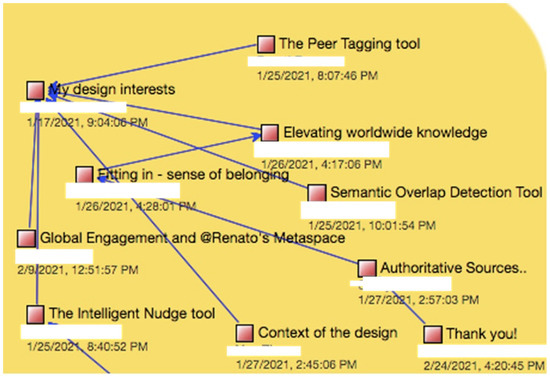
Figure 2.
A collection of Knowledge Forum notes illustrating build-on notes.
4.1.2. Views
Views are pages within Knowledge Forum that provide a backdrop for group notes. Views can be customized to reflect the needs of the community, whether that be graphical display, timeline, links to external content, or thematic organization. For example, in the two courses, separate views were created for small design groups to represent their work (Figure 3 and Figure 4). In the first course, a separate view was created for each week to discuss the week’s reading. Views can also be organized by participants, as in the second course where a separate personal journal view was created by each member. All views are accessible by the entire community to add and build on ideas or add additional content, unless the view creator specifies private view.
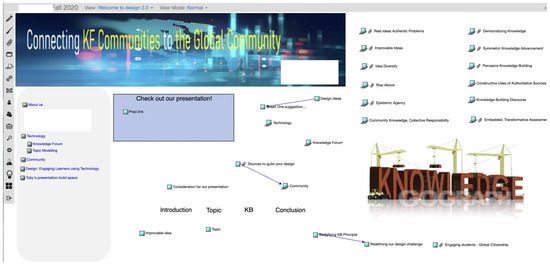
Figure 3.
Example of a design group view from course 1.
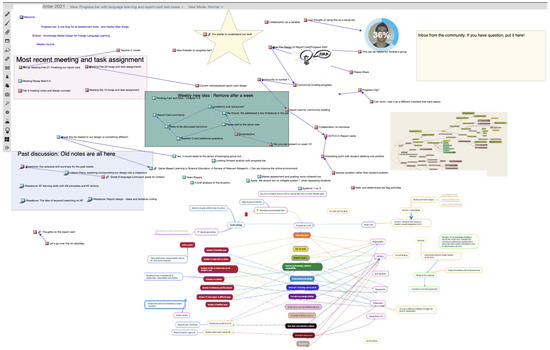
Figure 4.
Example of a design group view from course 2.
4.1.3. Scaffolds
Epistemic markers are an important feature in Knowledge Forum as they facilitate forms of discourse underrepresented in school discourse but essential for Knowledge Building/knowledge creation. An example of such discourse is theory building. The theory building scaffold shown in Figure 5 has been used to engage students in theory talk from grade one to tertiary education. Scaffold supports--phrases such as “I need to understand” or “putting our knowledge together”—vary in difficulty. Students select a phrase by clicking on it; it is entered into the note for integration into their discourse. Studies in early elementary school, with the theory building scaffold available for use but not compulsory, led to phrases such as “my theory,” and “I need to understand” in students’ written discourse. By various reports these discourse forms were also found in classroom talk, conversation on the playground and at home. Significant educational advantages have been reported [39]. In addition to embedding powerful discourse moves into student work, scaffolds can be searched and analyzed to view patterns of use, helping students to monitor and adjust contributions as work proceeds and to exercise epistemic agency in advancement of community knowledge [10].
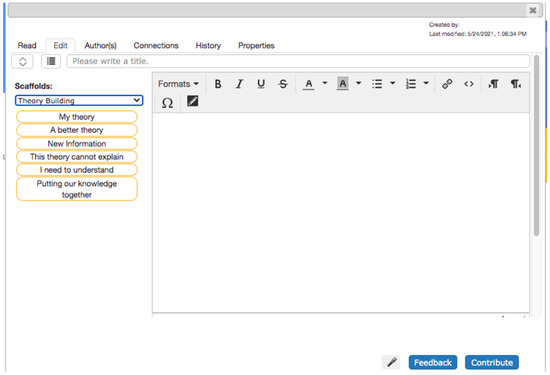
Figure 5.
Knowledge Forum note with a “Theory Building” scaffold.
Knowledge Building/knowledge creation is advanced through the public life of ideas—ideas made explicit and available to others who can help advance them. Knowledge Forum is a multimedia environment allowing students to represent ideas in the form of text, audio, images, video, models—many representational forms. It gives ideas a life beyond the mind of the originator and beyond transient conversation. Students were asked to use meaningful titles to facilitate search and review and to engage individually and as a group in the curation of ideas and views so visitors to their view could easily understand their work. Knowledge Forum was used in both courses.
4.2. Context and Participants
4.2.1. Course 1: Introduction to Knowledge Building
This course introduces students to Knowledge Building through engaging them in teamwork to advance a shared, top-level goal: use knowledge building principles to advance practices in their field. Students operate as designers, conveying designs as artifacts in Knowledge Forum, with design iterations to improve practices through reading, discussion, and help of community members. The focus is not on a final product but use of knowledge building principles as design parameters and Knowledge Forum as a design space. There were 23 graduate students enrolled in this course, all new to Knowledge Building and with diverse educational backgrounds and professional practices. They were encouraged to explore knowledge building potential in their areas of interest, contributing notes, designing views, and using analytics to assess their contributions, both as individuals and as a community.
The course included 12 sessions delivered synchronously once a week in the Fall 2020 term. Initially, we designed the course so that four sessions were mandatory whole-group sessions, with the remaining sessions optional to allow for small group design time. But optional sessions that provided a mix of design time and interaction with peers and instructors were attended by all students. In the first session, students were asked to create a biography note on Knowledge Forum to share their educational background and interests and highlight an educational challenge they faced. Students were encouraged to build on each other’s notes to explore diverse interests, find common interests, and form into small design groups. They were not required to join a team. Since contributions are entered into Knowledge Forum’s community space, all work is in an important sense teamwork. Team membership can change at any time, with exchanges facilitated by team views. All students read knowledge building articles and used the "reading-of-the-week" view to explore issues of application related to their professional contexts.
Eventually 9 design groups were formed, each with their own view on Knowledge Forum (Figure 6). Students showcased their progress and designs in the last two synchronous sessions.
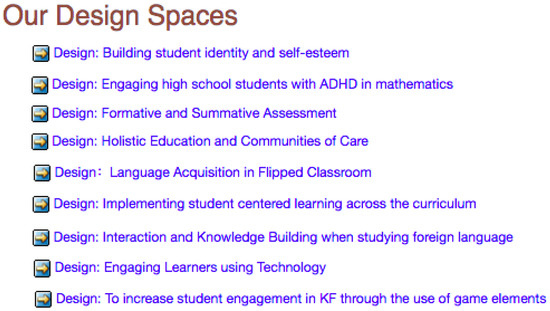
Figure 6.
List of design views in course 1.
Weekly Course Readings
Students read two articles per week. A new Knowledge Forum view was created each week for students to engage in knowledge building discourse around concepts covered in the readings. A “Why Knowledge Building, Why Now?” scaffold was used to encourage students to identify problems of understanding, myths, misconceptions, and new possibilities they uncovered as they read articles.
Although students demonstrated a high level of engagement, as suggested by the number of notes posted in the reading views (Table 1), students commented that discussions in their reading views and design-group views were not tightly connected. We experimented with having students discuss readings within their different design groups. Under both conditions students focussed more on discussion of general educational issues than on implications of what they read to generate design iterations. Generating principles-based design iteration seemed to be an especially difficult challenge.

Table 1.
Number of student notes in reading views.
Although students mostly worked within their own group, they explored the ideas of other groups and at times made connections and contributions. However, especially toward the end of the course, as they prepared for their design-group presentations to the class, they focused on their own ideas and connections to the shared course design goal. Next iterations of the course will need to provide better support for use of readings to inform design iterations and deeper integration of work within and across groups.
Synchronous Meetings
For the first session of the course, we built on the affordances of online learning to invite three panelists to address the question, “Why Knowledge Building, Why Now?” Panelists discussed their experiences with Knowledge Building and the expanded competencies and opportunities it affords in their various contexts. One panelist was an administrator of an Ontario-wide Leading Student Achievement initiative, another introduced Knowledge Building and Knowledge Forum to Inuit communities north of the Arctic Circle, and the third co-authored the Knowledge Building Gallery [40] based on work with teachers new to Knowledge Building. Their diverse experiences resonated well with students who came to the course with varied educational and professional backgrounds. The panelists conveyed their pleasure in starting students on their Knowledge Building journey and agreed to return for the last class. Given different locations of panelists, this rich conversation would not have been possible in a regular classroom setting. Students looked forward to presenting their work at the end of the class to these experienced professionals.
The rest of the synchronous sessions started with a whole-class discussion and time to discuss conceptual, design, or administrative issues, followed by use of the Zoom breakout room function to allow each design group to engage in focused design work. The instructor and two teaching assistants rotated between rooms, engaged as co-designers. After the breakout groups, the whole class came together again to provide updates of their work, learn more about each other’s designs, and find points of intersect across groups.
Synchronous sessions with all students together in the main Zoom room were recorded, and links to the recordings were posted in a Knowledge Forum note on the course home page. Recordings were helpful for students who were not able to join the synchronous session during class time, and they also provide opportunity to re-listen to segments to continue discussion of an idea entered there, although we are not aware of anyone who accessed recordings for that purpose.
4.2.2. Course 2: Digital Media and Practices for a Knowledge Society
The second course did not require that students take the first; however all but one of the 9 students in the second course had taken the first. As in the first course, students worked in small teams to advance a shared top-level goal; in this course, co-design of knowledge practices and technologies to enable a realistic model of students advancing knowledge for public good [8]. Students were guided by seven concepts in the knowledge creation literature.
Thinking Fast and Slow. These are two systems that drive the way we think. System 1 is fast, intuitive, and emotional; System 2 is slower, more deliberative, and more logical [41].
Self-Organization and Emergence. Self-organization is a dynamic process by which system order arises without external control; emergence occurs when something new arises from the interaction between individual parts of a system [42].
Edge of Chaos. This is the transition space between order and disorder where creative thinking and radical innovation can happen [43,44].
Design Thinking. Creative knowledge work requires participation in design activities to produce and develop new ideas [45].
Knowledge Creation. Knowledge is created through the intentional and purposeful generation of ideas. Ideas are artefacts that have a public life and interact with one another; students engaged in design thinking to collaboratively advance their ideas [25].
Beyond the Centralized Mindset. In making sense of complex systems, people often assume centralized causes and controls—where a single leader makes all the decisions [46]. Knowledge Building requires thinking beyond--thinking of students as epistemic agents able to take collective responsibility for knowledge advancement [47].
Explanatory Coherence. Explanatory Coherence assumes that a theory is more coherent if there is sound reasoning and explanation for the theory and its underlying facts and propositions [48,49].
As with the first course, students were asked to enter a biography note to introduce themselves, an educational challenge they faced, and how they believed education can be improved. As many students already knew each other, several students built on each other’s notes with statements like “Nice to see you again” or “Looking forward to work with you again.” Students were also asked to form design groups based on their common interests. As most students were familiar with each other’s work, three groups were formed right after the first class, one of which was a continuation of a design idea advanced in course 1.
This course spanned 13 weeks in the Winter 2021 term, with 11 classes. No classes were held weeks 10 and 11; rather, small groups self-organized meetings and in the last two sessions, groups presented their designs. We followed the same flow for synchronous classes as the first course: full class discussion, followed by Zoom breakout rooms for small-group design work, followed by a full class discussion of designs and issues arising from readings. There was no panel discussion in this course.
Weekly Course Readings
Instead of determining fixed weekly readings for all students in the class, we attached to the syllabus a list of articles and videos that address the seven knowledge creation key concepts. As with the first course, the expectation was for students to review two articles per week and provide commentary on Knowledge Forum on how these articles convey and support conceptual and design advances. Students were asked to use the “Key Concepts” and “Constructive Use of Authoritative Resources” scaffold to explore concepts (Figure 7 and Figure 8).
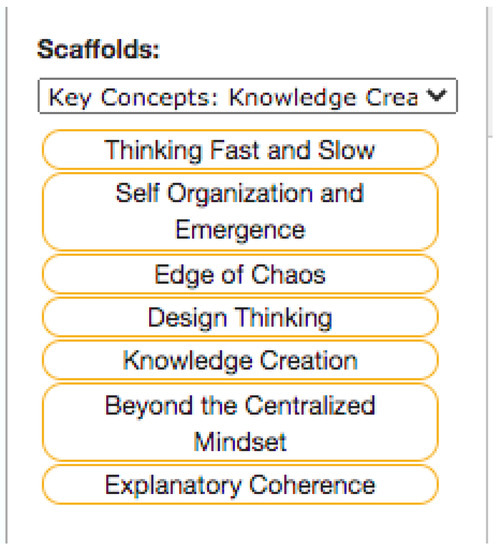
Figure 7.
Key Concepts scaffold.
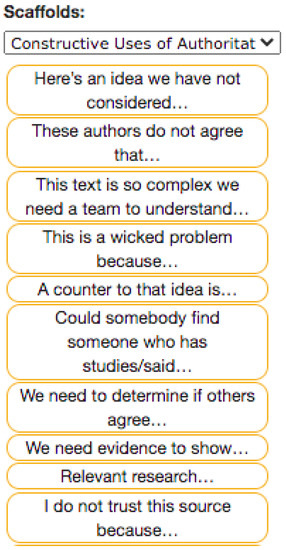
Figure 8.
Constructive Uses of Authoritative Sources scaffold.
In addition to design views, students were asked to create personal views to serve as their public journal space. Students were to add citations to the literature and commentaries to convey coverage of readings spanning all concepts. With the help of view rearrangement (description provided below), students were able to find notes that addressed the concept(s) they wished to discuss or learn more about.
5. Results
5.1. Assessment and Existing Analytics
In both courses, students submitted three portfolios—three checkpoints—to assess their contributions to community goals. As discussed below, we encouraged students to use data from idea building, scaffold growth, and key concepts analytics. At each checkpoint students received feedback and suggestions regarding promising directions.
5.1.1. Idea Building
The idea-building analytic (Figure 9) provides a social network view of level of connectedness between community members. Each circle represents a different student. The image in Figure 9 taken toward the end of the course indicates all students were connected at some level. The larger the circle the greater the number of connections, with arrow indicating direction of connection. Students can determine where they need to contribute more; for example, they can intentionally build on a note of someone new, producing an arrow out and enlarging their sphere of connectedness. As members read, reference, and build on other notes, they are better positioned to take collective responsibility for community knowledge. Is it possible to engage everyone? Democratizing knowledge suggests we should try. Qualitative accounts of efforts toward that end are provided by students in their portfolios.

Figure 9.
Idea building in course 1.
The following is a student’s qualitative account of personal idea-building results submitted as part of the portfolio self-assessment (Figure 10).
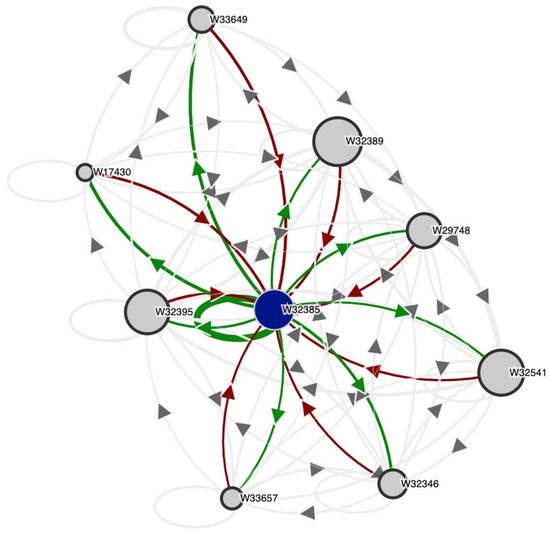
Figure 10.
Example of student idea-building portfolio self-assessment in course 2.
“Much of my work since the last portfolio has been done live with my group. Notes for these meetings were made under the authorship of our group (“Sense of Belonging”) to allow the other members to edit as needed. I’m not sure how group-authored notes are reflected in the analytics.I have admittedly fallen behind keeping up with the other groups’ design projects over the course of the last month of the class. I do see areas in which my work intersects with that of the other two groups. The “Enhanced KB Community Engagement” group’s work on norms of engagement directly relates to my ideas about community norms. Their work is more focused on using KF, but I believe both our theories would be enhanced by sharing ideas. The progress bar group’s work is aimed directly at increasing engagement.”
The student reflected on pattern of contribution within their small group and with other small groups.
5.1.2. Scaffold Growth
The scaffold growth analytic shows epistemic discourse moves based on the frequency of use of Knowledge Forum scaffold supports such as “My Theory,” “I Need to Understand,” etc. Through reviewing patterns of use, students gain a meta-level perspective on their contributions, allowing them to monitor the type of discursive moves that they are—or are not—making at any given time. Informal analysis suggests students tend to avoid difficult scaffolds and concepts. In the second course we ran the scaffold growth for the whole class to determine student engagement with the different key concepts (Figure 11). We found that students were more comfortable discussing and bringing forward ideas related to “Thinking Fast and Slow” and “Design Thinking,” but were less engaged with “Beyond the Centralized Mindset” and “Explanatory Coherence.”
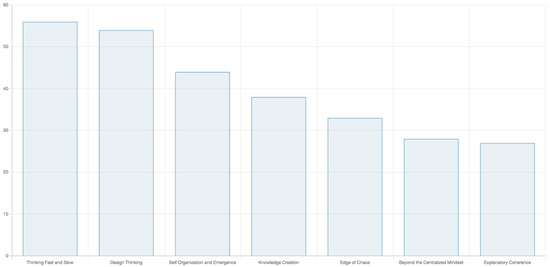
Figure 11.
Key Concepts scaffold growth in course 2.
Research indicates that viewing such results leads to productive discussion and more intentional integration of less frequently used concepts and discourse moves [50].
One student reflected on the use of this analytic in their portfolio by comparing the results of two consecutive months:
“I have been endeavoring to advance a shared vision, which could be proved by the growth in the ‘we’ scaffolds. The following bar charts were retrieved from KF on February 1 and March 1 separately. Last month, most of my notes were built around individual work and understanding. For example, scaffolds such as ‘I need to understand’, ‘my theory’, ‘an educational practice I would like to improve’ were most frequently in February, and the words ‘I’ and ‘my’ would be more likely related to isolated, individual work. This month, however, there was an obvious increase in the number of scaffolds with a ‘we’ thinking, such as ‘our design’, ‘here’s an idea we have not considered’, ‘we need to determine if others agree’, and etc. I have also been using the learning analytics embedded in KF to review my notes, scaffold my understanding of KB, and support my design, which can be proved by the total number and type of scaffolds I used in the month. The data indicated my efforts toward integrating design thinking into my research work toward the top goal of the community.”
5.1.3. Key Concepts
In the first course, the key concepts are the 12 Knowledge Building principles, and in the second course they are foundational concepts in the knowledge creation literature. The Key Concepts analytic is customizable to allow focus on concepts in any domain. Once concepts are identified it produces on demand a list of terms or phrases and title of the note(s) that contain these terms for each student (Figure 12). Hovering over the title shows the excerpt of the note that contains the term or phrase, and clicking the title opens the note in full. Thus, it is possible to see how frequently and in what contexts key concepts are in students’ productive vocabulary.
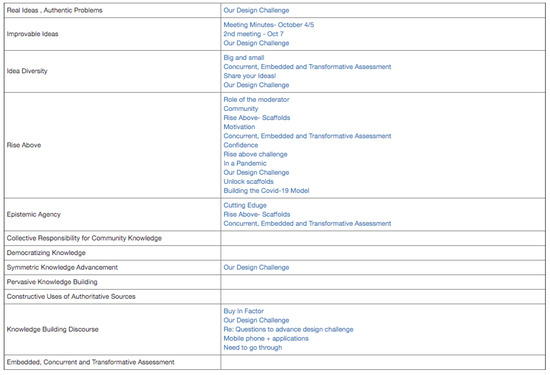
Figure 12.
Key Concepts for one student in course 1.
5.2. Metadiscourse
In order to exercise collective responsibility for knowledge advances students need the "big picture" of community knowledge as represented in their local community and authoritative sources. To apply principles, they need to work with them in design mode. To facilitate such work embedded scaffolds and view rearrangement were implemented.
5.2.1. Embedded Scaffolds
Embedded scaffolds allow users to apply multiple supports without need to toggle between scaffolds. Thus, for example, to encourage more principles-based design iterations we yoked the knowledge building principles scaffold with a “design mode” scaffold (see Figure 13). We aim to support demanding conceptual work suggested by design-mode items such as “A new idea that combines other ideas,” “A new understanding,” “A better example,” and “A better design.”
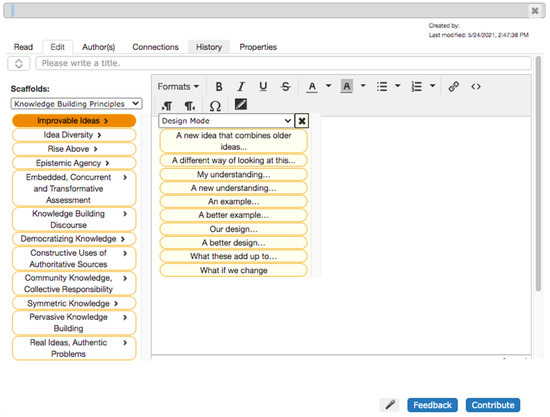
Figure 13.
Embedded scaffolds: knowledge building principles scaffold yoked to design mode scaffold.
5.2.2. View Rearrangement
View rearrangement allows users to display only those notes that use specific scaffolds/epistemic markers. As shown in Figure 14, the user selected for display all notes containing “Epistemic Agency”; “Real Ideas, Authentic Problems”; and “Knowledge Building Discourse” scaffolds. The title of each note containing these epistemic markers is displayed and users can click on the note icon to read the full note.
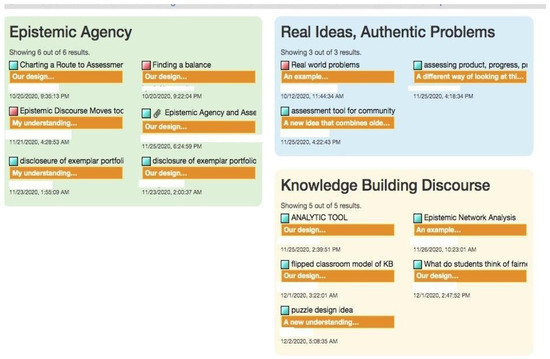
Figure 14.
View rearrangement showing the subset of notes that used the “Epistemic Agency”; “Real Ideas, Authentic Problems”; and “Knowledge Building Discourse” scaffolds.
In the second course, students who were in the first course and had prior experience using view rearrangement seemed to use it more intentionally. For example, one student noted, after re-arranging her notes to see use of key concepts
“For the next few weeks, I will aim to learn more about knowledge creation, explanatory coherence and edge of chaos. Most of the notes lie in design thinking and beyond the centralized mindset. This could be the evidence that I am engaging in the design mode for the past month. I also consider myself having some sense of thinking fast and slow.”
View rearrangement enables students to focus on contributions with particular scaffolds, reducing cognitive load associated with varied artefacts presented in a view. For example, students can view all notes containing “Putting Our Knowledge Together” or “A Better Design.”
6. Discussion and Reflections
Our reflections on the two questions posed at the beginning of this paper are based on student interactions observed during synchronous Zoom sessions, discussions on Knowledge Forum, and student written portfolios.
Bates’s [51] “law of equal substitution” is based on the assumption that coursework can be taught just as well online or in face-to-face mode. We examined two courses in which in-person meetings were impossible due to COVID-19 restrictions. As course instructors we explored new ways of advancing community knowledge through student engagement within and outside designated classroom time. We provided many and varied opportunities for students to generate and build on ideas and work with each other. For example, students contributed ideas to Knowledge Forum community spaces so that contributions were available for all class members to read and build on; students shared ideas with the entire class at weekly meeting, both before and after small-team breakout sessions; team members organized sessions anytime they wished and used supportive technology such as chat or WhatsApp, with summaries then recorded in Knowledge Forum; instructors recorded synchronous Zoom sessions and made them available for review and ongoing work in Knowledge Forum; and students used Knowledge Forum analytics to inform their work as it proceeded. Additionally, students received feedback from peers and instructors across these various contexts and discussions were not confined to linear, one person after another sharing of ideas or strict in-person defined periods of time; rather, there was anytime, anywhere access to the community knowledge space and analytics. Shy students and those less inclined to share in groups reported that different formats helped them; students also reported that they met in small groups outside of the allotted class time to formulate ideas and use analytics to assist in refining their work and conveying newly formulated ideas.
Question 1: Do courses that introduce Knowledge Building require an in-person or synchronous component?
Knowledge Building is interactive and dynamic by nature. The weekly Zoom sessions allowed students to work collaboratively in real time. Immediate feedback helped students refine their understanding of Knowledge Building and engage in design thinking and idea improvement. Synchronous sessions helped teams learn about designs of other teams, making it easier to gain an overview of work posted in various design spaces in Knowledge Forum. Almost all students had their cameras turned on during Zoom sessions, providing opportunity to see each other and helping to create a sense of community. Social interactions during synchronous whole-group and small-group Zoom sessions were interleaved with design time during asynchronous Knowledge Forum interactions and provided many opportunities for instructors to interact. Most student groups reported meeting synchronously outside class time, accentuating the need for synchronous time for collaborative design. In the first course, one student posted a note on Knowledge Forum with the title “SHOUT OUT TO EVERYONE!!!!,” inviting students to create a WhatsApp group and meet through Zoom to foster more conversation.
“If anyone needs some connecting, let’s make it happen. We can create a what’s app group to check in on each other and meet through zoom if necessary—even just to exchange thoughts and interact in a different, more personal way. I know we’re nearing the end of the course but it’s never too late! You can find me (...) on What’s App and contact me whenever. If not, leave a note in my portfolio and we’ll figure it out”
Question 2: In what ways can we leverage in-class time and Knowledge Forum work to engage students in more advanced knowledge creation?
Synchronous class time enables class-wide discussions, creates a sense of community, and is useful for interchanges across design groups. In future course iterations we plan to provide more time for groups to work together and for breakout groups, combining small-group design teams to facilitate more exchange of ideas.
In an attempt to make a connection across groups, one student noted that their Knowledge Forum interface recommendations connected with ideas of two other groups, one focused on norms of engagement and another on a progress bar to encourage more student engagement. The student noted that integrating all ideas would provide better results.
“We want to tie our interface changes to tie it to the group of sense of belonging—by co-creating norms of engagement would allow for ways of impaction through classroom expectations and to change how the student and teacher relationship allow for goals of the community, and authentic problems to be addressed. Having consequential results. To also add it to another group of transformative assessment they put together the tools created to all for more norms of engagement, but students as now the centre as idea creators—to allow for new ways to intersect, and with cutting edge of their fields. We also used the other group’s creation of a ’progress bar’ to have others try their design idea and other groups attempted to ask how it motivated their ideas.”
In future iterations, we will experiment with different patterns of information flow [19], rotating leadership [37,52], and embedded scaffold/view rearrangement with greater focus on cross-group work (e.g., we will include scaffolds such as “Putting Our Designs Together” or “Your Idea Helps My Design”).
Asynchronous work on Knowledge Forum is especially helpful for establishing objects of discourse that represent the interests of all students and that set the stage for knowledge creation. Ideas need a life beyond the mind of the creator and impermanence of conversation. Modern media make it easy to record conversations, but then who will listen to all those recordings? Knowledge Forum brings the following advantages to course work: intentional efforts to enter ideas into the public domain for sustained improvement, priority given to powerful discourse moves, accessibility of promising ideas, self-and group-assessment as work proceeds, and increased chances of engaging others in building on ideas for public good. Of course, the large number of notes students generate can be overwhelming; accordingly, we introduced embedded scaffolds and view rearrangement to make it easier to bring promising ideas into focus. Accessible, recorded ideas also allowed students to showcase and self-assess their work at critical reflection moments such as writing portfolios, aided by analytics to help them see gaps and inform next steps.
7. Limitations
This study describes efforts to engage students in productive knowledge building in two courses delivered fully online. One limitation is sample size, as both courses were relatively small, and both courses were conducted at the same institution. To ensure a more representative distribution of students and more generalizable results, the course design needs to be tested in different contexts with a larger sample size. Additionally, while we describe studies that explored the implementation of Knowledge Building in other graduate courses, the pandemic context is unique. While a great deal of additional research is needed, the work reported provides a starting point for combining synchronous and asynchronous Knowledge Building and for future work to analyze temporal changes and contributions of community members over extended periods of time.
8. Future Direction
Enhancements of Knowledge Forum reported in this paper allow community members to find ideas at points of intersection of different interests and designs within the community. Additional visualizations are under development so that students are better able to view the evolution of thought in the community. For the next iteration of the course, we aim to extend this work across communities. We will experiment with a public layer of the community space through which ideas are accessible to the Knowledge Building International community. Through sophisticated data mining and analytic techniques, we will experiment with a searchable metaspace to view ideas on various knowledge-for-public-good trajectories. Through such work we anticipate deeper engagement with course content and more sustained knowledge work that extends beyond course limits of time and space.
To further sustain Knowledge Building efforts, we are designing an international Knowledge Building program to engage researchers, practitioners, administrators, engineers in collaborative design and innovation. The goal is to bridge the gap between what happens in the classroom with what happens in the world beyond, to better address the complexity of problems in the global society.
Author Contributions
Conceptualization, D.S., M.S.; methodology, D.S., S.C., M.S.; software, D.S., S.C., M.S.; validation, D.S., S.C., M.S.; formal analysis, D.S., S.C., M.S.; investigation, D.S., S.C.; resources, D.S., S.C., M.S.; data curation, D.S., S.C., M.S.; writing-original draft preparation, D.S., S.C.; writing-review and editing, D.S., S.C., M.S.; visualization, D.S., S.C.; supervision, M.S.; project administration, D.S., S.C., M.S. All authors have read and agreed to the published version of the manuscript.
Funding
This research received no external funding.
Institutional Review Board Statement
A review board statement is not applicable as Canada’s three federal research agencies Tri-Council Policy does not require researchers to seek review board approval for anonymous data or non-identifiable information of the sort used in this report.
Informed Consent Statement
An informed consent statement is not applicable because research conducted in established educational settings, involving normal educational practices to improve instruction, does not require informed consent.
Data Availability Statement
A data sharing statement is not applicable, as restrictions on data access preclude data sharing.
Conflicts of Interest
The authors declare no conflict of interest.
References
- Fleischmann, K. Online design education: Searching for a middle ground. Arts Humanit. High. Educ. 2020, 19, 36–57. [Google Scholar] [CrossRef]
- Brown, J.S.; Duguid, P. The Social Life of Information; Harvard Business School Press: Brighton, MA, USA, 2000; Available online: https://hbswk.hbs.edu/archive/the-social-life-of-information (accessed on 26 May 2021).
- Palincsar, A.S.; Brown, A.L. Reciprocal teaching of comprehension-fostering and comprehension-monitoring activities. Cogn. Instr. 1984, 1, 117–175. [Google Scholar] [CrossRef]
- Hong, H.-Y.; Zhang, J.; Teo, C.; Scardamalia, M. Towards design-based knowledge-building practices in teaching. In Proceedings of the 9th International Conference on Computer Supported Collaborative Learning-CSCL’09, Rhodes, Greece, 8 June 2009; International Society of the Learning Sciences: Rhodes, Greece, 2009; Volume 1, pp. 257–261. [Google Scholar] [CrossRef]
- Scardamalia, M.; Bereiter, C. Knowledge Building: Theory, Pedagogy, and Technology. In Cambridge Handbook of the Learning Sciences; Sawyer, K., Ed.; Cambridge University Press: Cambridge, UK, 2006; pp. 97–118. [Google Scholar] [CrossRef]
- Scardamalia, M.; Bereiter, C. Knowledge Building. In Encyclopedia of Education, 2nd ed.; Gutherie, J.W., Ed.; Macmillan: New York, NY, USA, 2003; pp. 1370–1373. [Google Scholar]
- Bereiter, C.; Scardamalia, M. Learning to Work Creatively with Knowledge. In Powerful Learning Environments: Unraveling Basic Components and Dimensions; Advances in Learning and Instruction Series; de Corte, E., Verschaffel, L., Entwistle, N., van Merriënboer, J., Eds.; Elsevier Science: Oxford, UK, 2003; pp. 55–68. [Google Scholar]
- Scardamalia, M.; Bereiter, C. Two models of thinking in knowledge building. Rev. Catalana Pedagog. 2017, 12, 61–83. [Google Scholar] [CrossRef]
- Scardamalia, M. Collective Cognitive Responsibility for the Advancement of Knowledge. In Liberal Education in a Knowledge Society; Smith, B., Ed.; Open Court, 2002; pp. 67–98. Available online: https://ikit.org/fulltext/2002CollectiveCog.pdf (accessed on 26 May 2021).
- Scardamalia, M. CSILE/Knowledge Forum®. In Education and Technology: An Encyclopedia; ABC-CLIO: Santa Barbara, CA, USA, 2004; pp. 183–192. [Google Scholar]
- Scardamalia, M.; Bereiter, C. Knowledge Building and Knowledge Creation. In The Cambridge Handbook of the Learning Sciences, 2nd ed.; Sawyer, R.K., Ed.; Cambridge University Press: Cambridge, UK, 2014; pp. 397–417. [Google Scholar] [CrossRef]
- Vygotsky, L. Mind in Society: Development of Higher Psychological Processes; Harvard University Press: Cambridge, MA, USA, 1978. [Google Scholar]
- Gabora, L.; Kauffman, S. Toward an evolutionary-predictive foundation for creativity. Commentary on “Human creativity, evolutionary algorithms, and predictive representations: The mechanics of thought trials” by Arne Dietrich and Hilde Haider. Psychon. Bull.Rev. 2016, 23, 632–639. [Google Scholar] [CrossRef] [Green Version]
- Li, Y.; Kettinger, W.J. An evolutionary information-processing theory of knowledge creation. J. Assoc. Inf. Syst. 2006, 7, 593–617. [Google Scholar] [CrossRef] [Green Version]
- Lakatos, I. Falsification and the Methodology of Scientific Research Programmes. In Criticism and the Growth of Knowledge; Cambridge University Press: Cambridge, UK, 1970; pp. 91–196. [Google Scholar] [CrossRef]
- Scardamalia, M.; Bereiter, C. Smart technology for self-organizing processes. Smart Learn. Environ. 2014, 1, 1–3. [Google Scholar] [CrossRef] [Green Version]
- Chan, C.K.K.; van Aalst, J. Teacher development through computer-supported knowledge building: Experience from Hong Kong and Canadian teachers. Teach. Educ. 2006, 17, 7–26. [Google Scholar] [CrossRef]
- Hargreaves, D.H. The Knowledge-Creating School. Br. J. Educ. Stud. 1999, 47, 122–144. [Google Scholar] [CrossRef]
- Scardamalia, M.; Bereiter, C. “Fostering communities of learners” and “knowledge building”: An interrupted dialogue. In Children’s Learning in the Laboratory and in the Classroom: Essays in Honor of Ann Brown; Campione, J.C., Metz, K.E., Palincsar, A.S., Eds.; Erlbaum: Mahwah, NJ, USA, 2007; pp. 197–212. [Google Scholar]
- Lawrence, R.L. A small circle of friends: Cohort groups as learning communities. New Dir. Adult Contin. Educ. 2002, 95, 83–92. [Google Scholar] [CrossRef]
- Scardamalia, M.; Bereiter, C. A brief history of Knowledge Building. Can. J. Learn. Technol. 2010, 36. Available online: http://www.cjlt.ca/index.php/cjlt/article/view/26367/19549 (accessed on 26 May 2021). [CrossRef]
- Chen, B.; Hong, H.-Y. Schools as Knowledge-Building Organizations: Thirty Years of Design Research. Educ. Psychol. 2016, 51, 266–288. [Google Scholar] [CrossRef]
- Gilbert, N.J.; Driscoll, M.P. Collaborative knowledge building: A case study. Educ. Technol. Res. Dev. 2002, 50, 59–79. [Google Scholar] [CrossRef]
- Cesareni, D.; Cacciamani, S.; Fujita, N. Role taking and knowledge building in a blended university course. Int. J. Comput. Supported Collab. Learn. 2016, 11, 9–39. [Google Scholar] [CrossRef] [Green Version]
- Bereiter, C.; Scardamalia, M. Knowledge Building and Knowledge Creation: One Concept, Two Hills to Climb. In Knowledge Creation in Education; Tan, S.C., So, H.J., Yeo, J., Eds.; Springer: Singapore, 2014; pp. 35–52. [Google Scholar] [CrossRef]
- Sing, C.C.; Khine, M.S. An Analysis of Interaction and Participation Patterns in Online Community. Educ. Technol. Soc. 2006, 9, 250–261. [Google Scholar]
- Chai, S.; Zhu, G. The relationship between group adoption of Knowledge Building Principles and performance in creating artifacts. Educ. Tech. Res. Dev. 2021, 69, 787–808. [Google Scholar] [CrossRef]
- Hong, H.-Y.; Chen, F.-C.; Chai, C.S.; Chan, W.-C. Teacher-education students’ views about knowledge building theory and practice. Instr. Sci. 2011, 39, 467–482. [Google Scholar] [CrossRef]
- Chai, C.S.; Merry, R. Teachers’ perceptions of teaching and learning in a knowledge-building community: An exploratory case study. Learn. Media Technol. 2006, 31, 133–148. [Google Scholar] [CrossRef]
- Chai, C.S.; Tan, S.C. Professional Development of Teachers for Computer-Supported Collaborative Learning: A Knowledge-Building Approach. Teach. Coll. Rec. 2009, 111, 1296–1327. Available online: https://www.learntechlib.org/p/106062/ (accessed on 3 July 2021).
- Van Heijst, H.; de Jong, F.P.C.M.; van Aalst, J.; de Hoog, N.; Kirschner, P.A. Socio-cognitive openness in online knowledge building discourse: Does openness keep conversations going? Int. J. Comput. Supported Collab. Learn. 2019, 14, 165–184. [Google Scholar] [CrossRef] [Green Version]
- Ellis, G.W.; Rudnitsky, A.N.; Moriarty, M.A.; Mikic, B. Applying knowledge building in an engineering class: A pilot study. Int. J. Eng. Educ. 2011, 27, 945–957. [Google Scholar]
- Lax, L.; Singh, A.; Scardamalia, M.; Librach, L. Self-assessment for knowledge building in health care. QWERTY Interdiscip. J. Technol. Cult. Educ. 2006, 2, 19–37. [Google Scholar]
- Garrison, D.R.; Anderson, T.; Archer, W. Critical inquiry in a text-based environment: Computer conferencing in higher education. Internet High. Educ. 2000, 2, 87–105. [Google Scholar] [CrossRef] [Green Version]
- Scardamalia, M.; Bereiter, C. Schools as knowledge-building organizations. In Today’s Children, Tomorrow’s Society: The Developmental Health and Wealth of Nations; Keating, D., Hertzman, C., Eds.; Guilford: New York, NY, USA, 1999; pp. 274–289. [Google Scholar]
- Zhang, J.; Scardamalia, M.; Reeve, R.; Messina, R. Designs for collective cognitive responsibility in Knowledge-Building Communities. J. Learn. Sci. 2009, 18, 7–44. [Google Scholar] [CrossRef]
- Ma, L.; Matsuzawa, Y.; Scardamalia, M. Rotating leadership and collective responsibility in a grade 4 Knowledge Building classroom. Int. J. Organ. Des. Eng. IJODE 2016, 4, 54–84. [Google Scholar] [CrossRef]
- Scardamalia, M. Knowledge Forum (Advances beyond CSILE). J. Distance Educ. 2003, 17, 23–28. [Google Scholar]
- Chuy, M.; Scardamalia, M.; Bereiter, C.; Prinsen, F.; Resendes, M.; Messina, R.; Hunsburger, W.; Teplovs, C.; Chow, A. Understanding the nature of science and scientific progress: A theory-building approach. Can. J. Learn. Technol./La Rev. Can. L’apprentissage Technol. 2010, 36. [Google Scholar] [CrossRef] [Green Version]
- Resendes, M.; Dobbie, K. Knowledge Building Gallery: Leading Student Achievement: Networks for Learning Project. 2012. Available online: https://thelearningexchange.ca/wp-content/uploads/2017/04/Knowledge-Building-Booklet-Accessible-1.pdf (accessed on 20 July 2021).
- Kahneman, D. Thinking, Fast and Slow; Farrar, Straus, and Giroux: New York, NY, USA, 2011. [Google Scholar]
- De Wolf, T.; Holvoet, T. Emergence Versus Self-Organisation: Different Concepts but Promising When Combined. In Engineering Self-Organising Systems; Brueckner, S.A., di Serugendo, G., Karageorgos, A., Nagpal, R., Eds.; Springer: Berlin/Heidelberg, Germny, 2005; Volume 3464, pp. 1–15. [Google Scholar] [CrossRef]
- Bilder, R.M.; Knudsen, K.S. Creative cognition and systems biology on the edge of chaos. Front. Psychol. 2014, 5. [Google Scholar] [CrossRef] [Green Version]
- Conner, D. Leading at the Edge of Chaos: How to Create the Nimble Organization; John Wiley: Hoboken, NJ, USA, 1998. [Google Scholar]
- Paavola, S.; Hakkarainen, K. The Knowledge Creation Metaphor—An Emergent Epistemological Approach to Learning. Sci. Educ. 2005, 14, 535–557. [Google Scholar] [CrossRef]
- Resnick, M. Beyond the Centralized Mindset. J. Learn. Sci. 1996, 5. [Google Scholar] [CrossRef]
- Hewitt, J.; Scardamalia, M. Design Principles for Distributed Knowledge Building Processes. Educ. Psychol. Rev. 1998, 10, 75–96. [Google Scholar] [CrossRef]
- Thagard, P. Coherence in Thought and Action; MIT Press: Cambridge, MA, USA, 2000. [Google Scholar]
- Thagard, P. Coherence, Truth, and the Development of Scientific Knowledge*. Philos. Sci. 2007, 74, 28–47. [Google Scholar] [CrossRef] [Green Version]
- Resendes, M.; Scardamalia, M.; Bereiter, C.; Chen, B.; Halewood, C. Group-level formative feedback and metadiscourse. Int. J. Comput. Support. Collab. Learn. 2015, 10, 309–336. [Google Scholar] [CrossRef]
- Bates, A.W. Teaching in a Digital Age: Guidelines for Designing Teaching and Learning; Tony Bates Associates Ltd.: Vancouver, BC, Canada, 2015; ISBN 978-0-9952692-0-0. [Google Scholar]
- Gloor, P.A. Swarm Creativity: Competitive Advantage through Collaborative Innovation Networks; Oxford University Press: Oxford, UK, 2006. [Google Scholar]
Publisher’s Note: MDPI stays neutral with regard to jurisdictional claims in published maps and institutional affiliations. |
© 2021 by the authors. Licensee MDPI, Basel, Switzerland. This article is an open access article distributed under the terms and conditions of the Creative Commons Attribution (CC BY) license (https://creativecommons.org/licenses/by/4.0/).